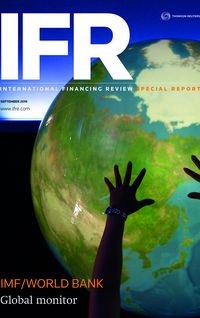GDP-linked sovereign bonds, whose principal and coupons fluctuate depending on the issuer’s economic performance, have taken a step closer to becoming a recognised part of international finance in recent months after they have been acknowledged in G20 communiques.
Finance ministers and central bank governors of the world’s 20 biggest economies, at their last meeting in late July, called for “further analysis of the technicalities, opportunities, and challenges of state-contingent debt instruments, including GDP-linked bonds”.
At that meeting in China, they also asked the International Monetary Fund, together with interested G20 members to report back on the issues to their group in 2017. Germany succeeds China as president of the G20 next year and may give its support to the GDP-linked bond initiatives.
Since then, a paper addressing likely obstacles to their launch has also been released.
Many of the technical points brought up by the paper, principally written by Bank of England staff, were discussed at a meeting of experts at the Bundesbank in August too, adding to the expectations that Germany is keen on the proposals. China’s main focus is supporting Green bonds.
So far, GDP-linked instruments have tended to be issued by financially distressed sovereigns as part of a wider debt exchange. Argentina, Greece and Ukraine all issued such instruments to potentially enhance the returns of creditors who accepted such exchanges.
These were mainly GDP warrants, which are rarely traded and hard to price. These older-style instruments have coupons that are indexed to GDP increases, if growth exceeds a specified hurdle, while returns are capped.
Pricing issues
But the latest iteration discussed in G20 circles is more like inflation-linked instruments in that their coupons and principal will fluctuate up and down depending on GDP growth and decline.
Under this initiative, more established borrowers would issue GDP-linked bonds. However, the Bank of England paper has identified some significant hurdles around pricing such novel instruments to ensure they had widespread appeal to investors.
“If there is no intersection between what issuers are willing to pay and what investors expect to receive, then there will be no market for these bonds,” it said.
Issuers might also be reluctant to start this market solo, since they might have to pay a premium to attract investors to buy the new bonds, whereas sovereigns following that lead might benefit from lower pricing, once the buyside became more familiar with the bonds’ structure and terms.
“One way to overcome the collective action problem … would be for a group of interested sovereigns to coordinate their issuance, enhancing the development of market infrastructure and standards,” said the paper.
It is still debatable if many issuers would feel the need to branch into GDP-linked notes, when there is currently such demand for their conventional instruments.
The paper disputed this, saying the case for launching GDP debt “may be especially strong now”, as an alternative instrument that could potentially provide an enhanced return.
Issuers, with above average levels of debt, might find issuing GDP-linked bonds particularly attractive, as it would effectively reduce their conventional debt levels.
Another way of encouraging sovereigns to issue would be for the IMF to amend “its debt sustainability analysis framework to make clear, for example through stress testing, the benefits offered through GDP-linked debt”.
This would make clear that this debt effectively reduced when a country’s GDP fell, making the sovereign less prone to the risk of default during tougher economic times.
It is understood the Bundesbank conference also discussed other technical issues brought up by the paper such as how to “hone in on a preferred structure that could be used to standardise future issuance”.
Term sheet
One of the major hurdles is the production of a model term sheet outlining standard legal conditions of a potential GDP-linked bond. Such a sheet was drafted by Allen & Overy and released at a workshop at the Bank of England last November.
The Bank of England’s governor Mark Carney opened that event, which was attended by major investors and representatives of other central banks and finance ministries, as well as multilateral institutions such as the International Monetary Fund and European Stability Mechanism.
An international financial architecture working group was established that then presented to the G20 at the IMF spring meetings in Washington DC.
The G20 at that meeting acknowledged “exploring the use of GDP-linked bonds” as one of its discussion points, alongside older initiatives, such as introducing enhanced collective action clauses in standard sovereign bonds.
Countries, investors and multilateral lenders like the new concept as it would help ease cashflow for a country with a distressed economy, possibly allowing an issuer to avoid a painful debt restructuring.
Those who designed the concept are hoping that a G20 country will issue the notes to show they are different from existing GDP warrants.
At a time when rates are at record lows, such instruments could prove an attractive option for investors – as inflation-linked bonds did when they were first developed.
Another possibility would be for central banks in the major economies, such as Japan, the UK, the US and the eurozone, all of which have recently built up large holdings of their respective country’s sovereign debt, to convert them into GDP bonds and so kick-start the market.
One criticism of existing GDP notes is that measuring GDP can be unreliable, with official figures frequently revised. For this reason, the term sheet suggests either paying a coupon only once a year, rather than semi-annually, or else paying the coupon a year in arrears to reflect any such fluctuations.
In addition, the term sheet says that if there is a dispute with the government statistics agencies, then the central bank should provide the GDP data, or, failing that, the IMF. If even that does not resolve a measuring dispute, then the term sheet suggests multiplying the previous year’s GDP by 1.1 times to penalise the country.
Paris Club
The G20 finance ministers and central bank governors have also backed some of the initiatives on sovereign debt put forward recently at the Paris Club of bilateral official sector creditors.
A principal concern is that China is a major creditor of emerging market nations but not a member of the Paris Club, leaving uncertainty as to how such debts might be restructured if that needs to happen.
“The rise of significant bilateral lenders, like China and India, that are not members of the Paris Club, has been a matter of concern for several years,” said Lee Buchheit, partner at law firm Cleary Gottlieb, who has advised numerous sovereigns on restructurings, including Greece and, most recently, Argentina.
“China, in particular, does not like to disclose the terms of its bilateral loans and certainly not the terms of the restructuring of those loans. This has no doubt been one reason why China has been reluctant to join the Paris Club.”
Venezuela, a prime candidate for a debt restructuring, said in July it was already in negotiations with China about restructuring an estimated US$50bn of bilateral liabilities.
But the nature of any deals between China and its creditors remain opaque, meaning other creditors may be reluctant to start their own discussions.
In earlier bouts of emerging market restructuring, the major bilateral lenders to sovereigns were Western countries, which were nearly all members of the Organisation for Economic Co-operation and Development and the Paris Club.
The latter body was set up so such creditors could informally reach agreement on how to treat these debts collectively.
China, which only started to lend in quantity to sovereigns after the last emerging markets debt crises of the 1990s, is not a member of this club and it is unclear how it will respond to sovereign debtors such as Venezuela if they are unable to meet their obligations.
“We support the Paris Club’s discussion of a range of sovereign debt issues, the ongoing work of the Paris Club, as the principal international forum for restructuring official bilateral debt, towards the broader inclusion of emerging creditors, and welcome the admission of the Republic of Korea to the Paris Club,” said the G20.
“We welcome China’s regular participation in Paris Club meetings and intention to play a more constructive role, including further discussions on potential membership.”
For the moment however, China may cut its own deals with countries. That would potentially spoil the essential precept of Paris Club deals: that all other creditors, official or private, must either accept the same (or worse) terms as those given to Paris Club creditors – but nothing better.
To see the digital version of this special report, please click here
To purchase printed copies or a PDF of this report, please email gloria.balbastro@tr.com



